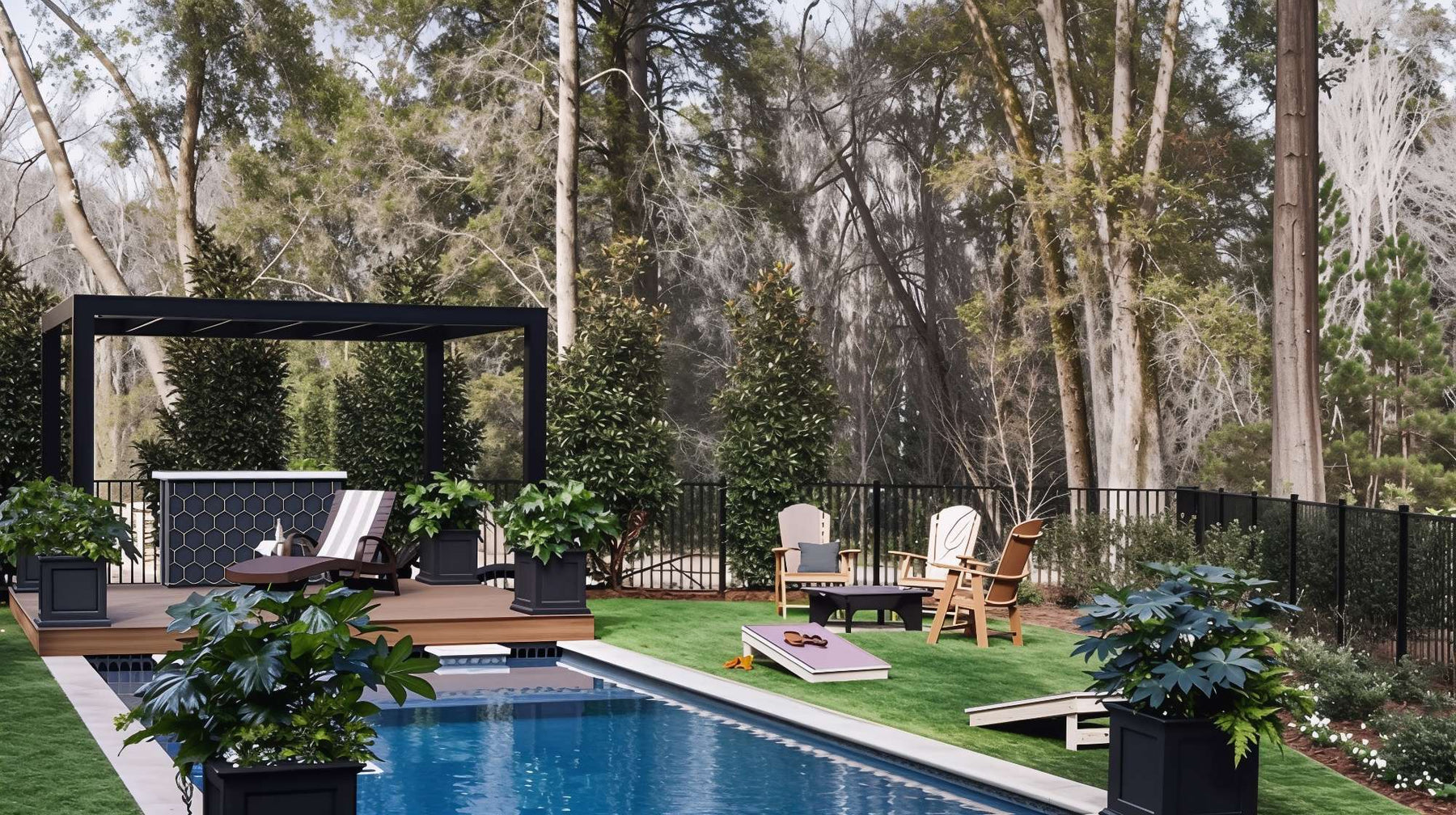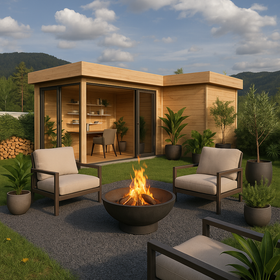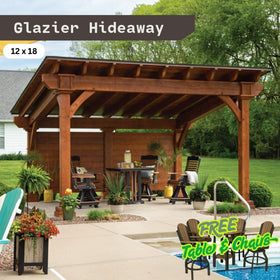512-777-0154

Wood vs. Aluminum Pergolas: What’s Right for You?
A well-placed pergola can turn a plain backyard into a space that feels like part of your home. It adds structure. Shade. A bit of beauty. Suddenly, that patch of grass becomes a place where you want to sit down and stay a while.
But now you’ve hit the big question: wood or aluminum?
Lumber gives you that classic, natural look. It feels warm. Familiar. It blends in with trees, decks, and garden spaces. But it also asks for attention: maintenance, care, and time.
Aluminum can offer a cleaner, more modern vibe. It stands up to heat, rain, and long summers without breaking a sweat. No sealing. No staining. Just set it up and forget about it.
Both materials can make your outdoor space better. Both have their strengths. But they come with different pros, trade-offs, and price tags.
So which one fits you best?
How Wood and Aluminum Pergolas Compare
Pergolas can change how your patio looks, feels, and functions. But choosing the right material? That’s where things get tricky.
Wood and aluminum pergolas each bring something different to the table. One leans warm and natural. The other, clean and modern. You’ll find differences in design, cost, durability, and how much care each one needs.
This isn’t about picking a winner. It’s about finding what works for your space, climate, and lifestyle.
So let’s walk through the side-by-side comparisons. From corrosion and rust resistance to aesthetics and roof options. We’ll cover it all: wind, moisture, metal vs. lumber, powder coating, and more.
1. Material (Pros & Cons)
A wooden pergola uses natural lumber like cedar, redwood, or pressure-treated pine. It feels grounded. There’s something about real wood that adds warmth and charm to any outdoor space. But wood also needs help staying that way. It can crack, warp, or attract pests over time, especially if it’s exposed to moisture, wind, or harsh sun. You’ll also need to stain or seal it every so often to keep it in good shape.
Aluminum is tough. Lightweight but strong. Many aluminum pergolas are powder-coated, which adds a protective finish and extra style. It resists corrosion, moisture, and rust. Insects leave it alone. And wind? It holds up surprisingly well, especially when installed properly.
Aluminum can look and feel a bit cold or industrial. And while it’s metal, it’s not as heavy-duty as steel. But for most homes, that’s a good thing. You don’t need a crane to install it.
Wood brings beauty with a bit of upkeep. Aluminum brings durability with less effort.
2. Looks Matter
Let’s talk about design. Because how your pergola looks matters just as much as how it works.
Wood has a classic, grounded feel. It gives you that earthy, natural look that blends right into a landscape. If your home leans rustic, coastal, or traditional, a wooden pergola fits right in. Over time, it can take on a weathered, lived-in look, something some people love and others don’t.
Aluminum pergolas? They go in a different direction. Clean lines. Sharp edges. Often finished with powder coating that adds color without the maintenance. If your style leans modern, minimal, or geometric, aluminum makes sense. It pairs well with concrete patios, structured gardens, and angular architecture.
One isn’t better than the other. They just do different things visually.
So it comes down to your home’s vibe. Do you want a pergola that disappears into nature? Or one that stands out with a metal frame and bold shape?
Aesthetics are personal. But in this case, they’re also practical. The material you choose will set the tone for your entire outdoor space.
3. Maintenance
An aluminum pergola doesn’t ask for much. No staining. No sealing. No weekend touch-ups. It holds up to moisture, blocks rust, and shrugs off UV damage. The powder-coated finish keeps the surface looking clean year after year. If it gets dusty or dirty? Hose it down and walk away.
Wood is different. You’ll need to check it regularly for signs of weathering. Sun and rain can cause cracks or fading. Insects might take an interest. And if moisture seeps in, it can lead to rot.
Maintenance for a wooden pergola usually means re-staining or sealing it every couple of years. Skip that, and it starts to look worn fast. If you live in a place with wet winters or blazing summers, expect to do a bit more.
That doesn’t mean wood is a bad option. But it does mean you’ll be putting in some work or hiring someone else to do it.
If you’re after something you can install and ignore, aluminum’s a safer bet. If you’re okay with regular upkeep, wood rewards you with character and charm. Just know what you’re signing up for.
4. Cost Up Front vs. Cost Over Time
A wooden pergola is often cheaper upfront. Especially if you go with pressure-treated lumber instead of cedar or redwood. You can build it yourself, too, which keeps labor costs down.
On the surface, it feels like a solid deal. But over time, the cost starts to climb. Staining. Sealing. Replacing cracked beams or damaged posts. It adds up, especially if you’re not doing the work yourself.
Aluminum pergolas cost more at the start. They’re usually pre-fabricated, and installation can be a bit pricier. But once it’s up, you’re basically done. No annual maintenance costs. No repairs unless something major happens.
So it comes down to how you like to spend money. Want to pay more upfront and avoid the hassle later? Aluminum makes sense. Want to save money now and spread the cost over the years? Wood works, just budget for the upkeep.
Also, the price difference between a metal pergola and a wooden one can vary a lot depending on design, size, and region. So always get a few quotes before making the final call.
5. Durability and Weather Resistance
If you live somewhere that gets real weather, like hot summers, wet winters, or high humidity, this section matters.
Aluminum pergolas are built for conditions like that. Moisture rolls off. Heat doesn’t cause warping. Powder coating protects the metal from corrosion. Bugs don’t care about it. And if wind is a concern, aluminum holds steady as long as it’s anchored properly.
Wood, on the other hand, needs more protection. It can last for years, sometimes decades, but only with consistent care. If you get heavy rain or snow, water can seep in and cause swelling or rot. In dry, sunny areas, UV rays can crack and fade the surface over time.
That said, not all wood is created equal. Cedar and redwood naturally resist decay better than cheaper lumber. And if you're on top of your maintenance game, a wooden pergola can hold up just fine in most climates.
6. Customization and Flexibility
Wood wins here. You can cut it, stain it, shape it, and tweak it to fit almost any design idea. Want curves? You can carve them. Want a specific shade? Pick a stain or paint that matches your space. Building around an awkward corner or uneven patio? Wood gives you options.
Aluminum is more streamlined. Most come in set sizes and modular kits. That makes installation faster, but limits creativity. Powder coating offers some color choice, but beyond that, customization is minimal.
If your goal is something bold, unusual, or totally one-of-a-kind, wood gives you the tools to get there. If you’d rather keep it simple and clean, aluminum does the job without fuss.
Both materials can look great. But only one lets you play architect.
Which One Best Fits You?
- Do you like hands-on home projects? Wood might be your thing. You can stain it, seal it, and tweak it as styles or seasons change.
- Prefer something “set and forget”? Go with aluminium. It lasts long, resists the elements, and won’t bug you for attention.
- Leaning toward a traditional, cozy backyard look? A wooden structure blends in easily. It works well next to gardens, fences, and older homes.
- Going for a modern setup with clean lines? Metal pergolas look sharper and often match better with newer homes, patios, or minimal landscaping.
- Live somewhere hot, rainy, or full of bugs? Aluminium wins in durability. It handles moisture, wind, and sun without cracking or rotting.
- Thinking long-term? Aluminium tends to win on longevity. Especially if you don’t want to be climbing ladders later to reseal anything.
- Want to attach an awning or cover? Both materials work, but metal frames often make it easier.
Related: Where to Put a Pergola?
How to Land on the Right Pergola for You
Choosing between wood and aluminum isn’t just about style. It’s about how you live.
Wood gives you that warm, classic look. It feels natural. But it also asks for regular care. If you don’t mind the upkeep, it rewards you with charm and flexibility.
Aluminium leans modern. It’s clean, strong, and built to last. No sealing. No staining. Just a low-effort way to add shade and structure that holds up over time.
So take a breath. Think about your space and how you'll decorate it. Think about your schedule. You don’t have to decide today.
And if you're still weighing your options, that’s fine too. Keep digging. We’ve got more blogs to help you sort through the details without getting overwhelmed.










